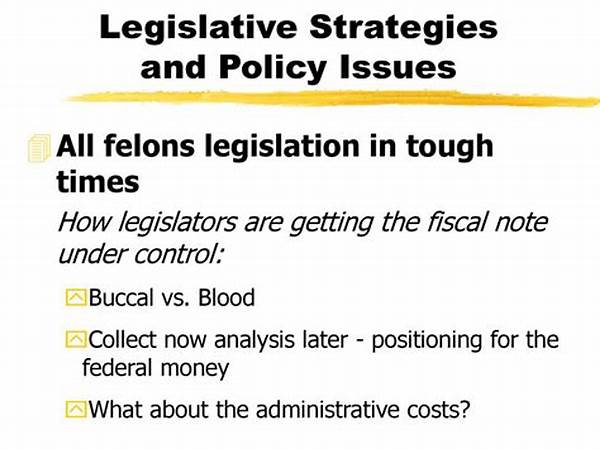In a world where political divides can seem insurmountable, consensus-driven legislative policy strategies stand out as beacons of hope. These strategies focus on finding common ground and working collaboratively to shape policies that are both effective and inclusive. By fostering dialogue, understanding, and compromise, consensus-driven approaches have the potential to bridge gaps and draw support from diverse groups. This expository article delves into the essence of consensus-driven strategies within the legislative framework, revealing how they function and why they are critical in today’s political landscape.
Read Now : Climate Change Impact Analysis
The Art of Building Bridges
Consensus-driven legislative policy strategies are all about building bridges—figuratively, of course. Picture this: instead of intense debates with everyone shouting across the aisle, policymakers actually sit down, listen, and hash things out. The emphasis here is on collective decision-making that reflects a broad spectrum of interests. Such strategies aim to create win-win scenarios rather than zero-sum outcomes, where one side’s gain isn’t another’s loss. By integrating diverse viewpoints, these strategies craft policies that resonate widely and garner broader acceptance. This not only leads to more durable policies but also strengthens the credibility and legitimacy of legislative bodies. With consensus-driven legislative policy strategies, it’s about making sure everyone’s voice is heard and finding that sweet spot where multiple interests align.
Five Key Strategies for Achieving Consensus
1. Open Dialogue: Encouraging honest and open communication to build trust among stakeholders utilizing consensus-driven legislative policy strategies.
2. Compromise: It’s all about give-and-take, ensuring everyone gets a piece of their pie.
3. Inclusivity: Making sure all voices, especially marginalized ones, are part of the decision-making process.
4. Flexibility: Being willing to adjust positions and meet others halfway in consensus-driven legislative policy strategies.
5. Shared Goals: Finding common ground to rally everyone around a unified mission or objective.
Crafting Policies That Resonate
When it comes to consensus-driven legislative policy strategies, the secret sauce lies in the art of crafting policies that truly resonate with the broader populace. Imagine policymakers not only taking notes from their constituents but genuinely understanding the pulse of the people. This approach requires a deep appreciation of the varied needs, values, and aspirations of different communities. By tapping into widespread sentiments and concerns, legislators can develop solutions that reflect the collective wisdom of society. Consensus-driven strategies ensure that policy-making is not just a top-down imposition but a reflection of grassroots aspirations. It’s a process where dialogue is paramount, and every voice counts, leading to results that are not just accepted but embraced by all.
How Consensus Strategies Impact Legislative Effectiveness
1. Broader Buy-in: Consensus strategies pave the way for wider acceptance and buy-in from all sides.
2. Sustainability: Policies born from consensus-driven legislative policy strategies tend to endure over time.
3. Increased Trust: Building trust between opposing sides leads to smoother cooperation in the future.
4. Enhanced Credibility: Legislative bodies seen as more representative and credible.
Read Now : Electrifying Music For Workouts
5. Empowered Citizens: Public feels engaged and respected in the policy-making process.
6. Efficient Implementation: Policies are more likely to be implemented smoothly when there’s consensus.
7. Conflict Reduction: Minimizes the risk of disputes and enhances collaboration.
8. Integrated Solutions: Combines diverse perspectives into comprehensive solutions.
9. Greater Innovation: Encourages creative solutions by bringing together varied viewpoints.
10. Adaptability: Allows for policies to evolve with changing circumstances thanks to consensus-driven legislative policy strategies.
Embracing Consensus in a Polarized World
In today’s politically charged environment, embracing consensus-driven legislative policy strategies can feel like a breath of fresh air. These strategies are a counter-narrative to the antagonism and polarization that seem to dominate our news cycles. By emphasizing dialogue and collaboration over competition and conflict, consensus-driven approaches can usher in a new era of legislative effectiveness. It’s about creating a democratic space where every opinion is valued, and differences are seen as opportunities for growth rather than roadblocks. With these strategies, lawmakers can craft policies that stand the test of time, nurtured by mutual respect and understanding. The result? A political landscape that feels less combative and more cooperative, where progress isn’t stalled by division but accelerated by unity.
The Challenges and Rewards of Consensus Building
Of course, consensus-driven legislative policy strategies aren’t without their hurdles. It takes time, patience, and a whole lot of listening to bring diverse parties together. But here’s the kicker—when it works, it works wonders. The payoff is huge; think of policies that last longer, communities that feel heard, and a political process that earns respect rather than skepticism. It’s a reminder that the best solutions are often the ones that aren’t forced but are cultivated through shared understanding. In a world where shouting matches too often drown out civil discourse, consensus-driven strategies signal a path forward—a path that cherishes collaboration over confrontation, building a legislative foundation that’s as resilient as it is visionary.
Conclusion: The Path Forward with Consensus
To wrap it all up, consensus-driven legislative policy strategies are not just about ticking boxes and getting “nay” turned into “aye.” They encapsulate the essence of democracy—a system where everyone’s voices matter and no one’s left out in the cold. Through these strategies, lawmakers stand a better chance of crafting policies that are not only pragmatic and efficient but also just and inclusive. The future of governance could very well hinge on our ability to embrace consensus, welcoming every voice to the table and prioritizing dialogue over discord. As society navigates complex challenges, consensus-driven strategies offer a beacon of hope, promising a legislative landscape where progress is synonymous with partnership and unity.
